See also
| | This article about an ethnic group in Europe is a stub. You can help Wikipedia by expanding it. |
The Cobandi, Greek Kobandoi, were a Germanic tribe mentioned in Ptolemy's Geography (2.10), who lived in Jutland.
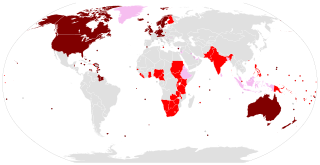
The Germanic languages are a branch of the Indo-European language family spoken natively by a population of about 515 million people mainly in Europe, North America, Oceania and Southern Africa. The most widely spoken Germanic language, English, is also the world's most widely spoken language with an estimated 2 billion speakers. All Germanic languages are derived from Proto-Germanic, spoken in Iron Age Scandinavia.
German(s) may refer to:

The Germanic peoples were a historical group of people living in Central Europe and Scandinavia. Since the 19th century, they have traditionally been defined by the use of ancient and early medieval Germanic languages and are thus equated at least approximately with Germanic-speaking peoples, although different academic disciplines have their own definitions of what makes someone or something "Germanic". The Romans named the area in which Germanic peoples lived Germania, stretching West to East between the Vistula and Rhine rivers and north to south from Southern Scandinavia to the upper Danube. In discussions of the Roman period, the Germanic peoples are sometimes referred to as Germani or ancient Germans, although many scholars consider the second term problematic, since it suggests identity with modern Germans. The very concept of "Germanic peoples" has become the subject of controversy among modern scholars, with some calling for its total abandonment.
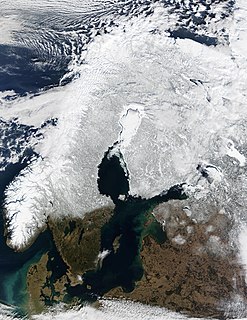
Scandinavia is a subregion in Northern Europe, with strong historical, cultural, and linguistic ties.

Yule is a festival historically observed by the Germanic peoples. Scholars have connected the original celebrations of Yule to the Wild Hunt, the god Odin, and the pagan Anglo-Saxon Mōdraniht.
Germans are the natives or inhabitants of Germany, and sometimes more broadly any people who are of German descent or native speakers of the German language. The constitution of Germany defines a German as a German citizen. During the 19th and much of the 20th century, discussions on German identity were dominated by concepts of a common language, culture, descent and history. Today, the German language is widely seen as the primary though not exclusive criterion of German identity. Estimates on the total number of Germans in the world range from 100 to 150 million, and most of them live in Germany.
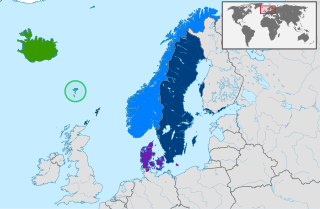
The North Germanic languages make up one of the three branches of the Germanic languages—a sub-family of the Indo-European languages—along with the West Germanic languages and the extinct East Germanic languages. The language group is also referred to as the "Nordic languages", a direct translation of the most common term used among Danish, Faroese, Icelandic, Norwegian, and Swedish scholars and people.

The Norsemen were a North Germanic ethnolinguistic group of the Early Middle Ages, during which they spoke the Old Norse language. The language belongs to the North Germanic branch of the Indo-European languages and is the predecessor of the modern Germanic languages of Scandinavia. During the late eighth century, Scandinavians embarked on a large-scale expansion in all directions, giving rise to the Viking Age. In English-language scholarship since the 19th century, Norse seafaring traders, settlers and warriors have commonly been referred to as Vikings. Historians of Anglo-Saxon England distinguish between Norse Vikings (Norsemen) from Norway who mainly invaded and occupied the islands north and north-west of Britain, Ireland and western Britain, and Danish Vikings, who principally invaded and occupied eastern Britain.
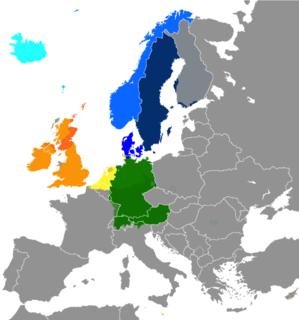
The West Germanic languages constitute the largest of the three branches of the Germanic family of languages.

Proto-Germanic is the reconstructed proto-language of the Germanic branch of the Indo-European languages.

Germania, also called Magna Germania, Germania Libera or Germanic Barbaricum to distinguish it from the Roman provinces of the same name, was a large historical region in north-central Europe during the Roman era, which was associated by Roman authors with the Germanic peoples. The region stretched roughly from the Middle and Lower Rhine in the west to the Vistula in the east. It also extended as far south as the Upper and Middle Danube and Pannonia, and to the known parts of Scandinavia in the north. Archaeologically, these peoples correspond roughly to the Roman Iron Age of those regions. While apparently dominated by Germanic peoples, Magna Germania was also inhabited by Celts.
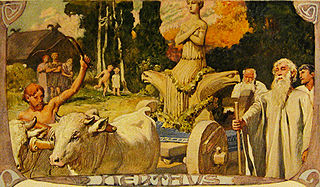
Germanic mythology consists of the body of myths native to the Germanic peoples, including Norse mythology, Anglo-Saxon mythology, and Continental Germanic mythology. It was a key element of Germanic paganism.

The East Germanic languages, also called the Oder–Vistula Germanic languages, are a group of extinct Germanic languages spoken by East Germanic peoples. East Germanic is one of the primary branches of Germanic languages, along with North Germanic and West Germanic.

Runes are the letters in a set of related alphabets known as runic alphabets. Runes were used to write various Germanic languages before the adoption of the Latin alphabet and for specialised purposes thereafter. In addition to representing a sound value, runes can be used to represent the concepts after which they are named (ideographs). Examples of this are often referred to as Begriffsrunen by academics. The Scandinavian variants are also known as futhark or fuþark ; the Anglo-Saxon variant is futhorc or fuþorc.

Germanic paganism included various religious practices of the Germanic peoples from the Iron Age until Christianisation during the Middle Ages. Religious practices represented an essential element of early Germanic culture. From both archaeological remains and literary sources, it is possible to trace a number of common or closely related beliefs among the Germanic peoples into the Middle Ages, when the last areas in Scandinavia were Christianized. Rooted in Proto-Indo-European religion, Proto-Germanic religion expanded during the Migration Period, yielding extensions such as Old Norse religion among the North Germanic peoples, the paganism practiced amid the continental Germanic peoples, and Anglo-Saxon paganism among the Old English-speaking peoples. The Germanic religion is best documented in 10th- and 11th-century texts from Scandinavia and Iceland.
German studies is the field of humanities that researches, documents, and disseminates German language and literature in both its historic and present forms. Academic departments of German studies often include classes on German culture, German history, and German politics in addition to the language and literature component. Common German names for the field are Germanistik, Deutsche Philologie, and Deutsche Sprachwissenschaft und Literaturwissenschaft. In English, the terms Germanistics or Germanics are sometimes used, but the subject is more often referred to as German studies, German language and literature, or German philology.
Continental Germanic mythology formed an element within Germanic paganism as practiced in parts of Central Europe occupied by Germanic peoples up to and including the 6th to 8th centuries. Traces of some of the myths lived on in legends and in the Middle High German epics of the Middle Ages. Echoes of the stories, with the sacred elements largely removed, may appear throughout European folklore and in European fairy tales.
In historical linguistics, the Germanic parent language (GPL) includes the reconstructed languages in the Germanic group referred to as Pre-Germanic Indo-European (PreGmc), Early Proto-Germanic (EPGmc), and Late Proto-Germanic (LPGmc), spoken in the 2nd and 1st millennia BC.

Gothic is an extinct East Germanic language that was spoken by the Goths. It is known primarily from the Codex Argenteus, a 6th-century copy of a 4th-century Bible translation, and is the only East Germanic language with a sizeable text corpus. All others, including Burgundian and Vandalic, are known, if at all, only from proper names that survived in historical accounts, and from loanwords in other languages such as Portuguese, Spanish, and French.

Early Germanic culture refers to the culture of the early Germanic peoples. Largely derived from a synthesis of Proto-Indo-European and indigenous Northern European elements, the Germanic culture developed out of the Nordic Bronze Age. It came under significant external influence during the Migration Period, particularly from ancient Rome.